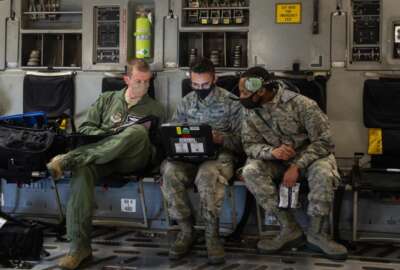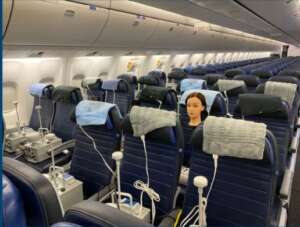

According to the study, under normal conditions on a commercial jetliner, it would take several consecutive days onboard an aircraft for one COVID-infected...
The DoD Reporter’s Notebook is a weekly summary of personnel, acquisition, technology and management stories that may have fallen below your radar during the past week, but are nonetheless important. It’s compiled and published each Monday by Federal News Network DoD reporters Jared Serbu and Scott Maucione.
In the midst of pandemic, all available evidence shows it’s a very good idea to keep oneself away from large gatherings of other people and to avoid unnecessary travel. But if you really need to go somewhere, it’s extraordinarily unlikely that you’ll contract the virus during a plane flight.
That’s according to a just-finished study by U.S. Transportation Command and the Defense Advanced Research Projects Agency, which officials say is the largest study of airborne particles in airplanes that’s ever been conducted.
Defense officials launched the research to help determine the risks of moving service members and their families aboard contracted commercial aircraft — most commonly the Boeing 777 and 767 jets collectively dubbed the “Patriot Express.” The test estimated you’d need to be sitting on the same airplane with a COVID-infected passenger for 54 straight hours before you inhaled enough viral particles to become infected.

That’s almost entirely because there’s a whole lot more fresh air on a modern commercial jet than many people assume. According to the study, their air handlers exchange more air from the outside — and recirculate it through HEPA filters — than most hospitals and biosafety-level 3 laboratories. Researchers say it takes about six minutes to remove a single airborne particle from an airplane, compared to 104 minutes in an average American home. And aside from the volume of air movement, the ventilation systems are designed in such a way that cabin air is continually pressed downward, making it very difficult for an infected droplet to float around and settle on a surface like an armrest.
To calculate the risks, researchers seated a mannequin in more than 40 different locations on the airplanes and outfitted it to “exhale” traceable fluorescent and DNA-tagged particles that mimic the airborne droplets that carry the virus. At the same time, they set up sensors in 40 different seating zones to determine how many of those infected particles could reach another passenger.
They found the risks of infection are noticeably higher if you’re seated in the same row as an infected passenger – or the rows ahead of or behind them. But even for simulated passengers sitting right next to a simulated infected one, researchers couldn’t come up with an instance where a traveler would have inhaled the 1,000 virons assumed to be necessary to contract COVID-19.
Nonetheless, Defense researchers acknowledge the study has its limitations.
“Specifically, it only considered a single infected passenger and did not attempt to gather data reflecting passenger movement about the cabin,” said Cmdr. Joe Pope, a TRANSCOM liason for the research project. Still, he said, the results are “encouraging.” —JS
On the heels of $600 million in contracts the Defense Department awarded for 5G networks on bases, two top lawmakers on the House Energy and Commerce Committee are questioning agreements’ legal underpinnings.
House Energy and Commerce Committee Chairman Frank Pallone (D-N.J.) and Communications and Technology Subcommittee Chairman Mike Doyle (D-Pa.) are asking the Government Accountability Office to look into the legality of DoD’s 5G operations.
In September, DoD unveiled a plan to create its own 5G network, which Pallone and Doyle think steps on the toes of other agencies.
In a letter to GAO, the two legislators are wondering whether the Pentagon “has the legal authority to construct, operate, or maintain a commercial communications network or lease its assigned electromagnetic spectrum to private entities to provide commercial communications service.”
The representatives state they do not think DoD has the authority.
“We are concerned that DoD’s recent activities ignore the National Telecommunications and Information Administration statutory role and undermine the NTIA’s ability to effectively represent the interests of other federal agencies and further national spectrum policy,” they wrote to NTIA in a separate letter. “To date, the Trump Administration’s spectrum management practices have been incoherent and erratic, which puts the nation’s 5G future at risk.”
The Pentagon and White House are moving quickly on 5G.
DoD also announced that it will help the Federal Communications Commission sell of some spectrum at the end of 2021.
The Pentagon is already building experimental networking on its bases. There are 12 bases working on 5G networks or building them. The $600 million contract will add Joint Base Lewis-McChord in Washington, Hill Air Force Base in Utah, Naval Base San Diego, Marine Corps Logistics Base in Georgia and Nellis Air Force Base in Nevada to that list.
GAO recently put out a report stating the Trump administration’s 5G strategy is lacking and the National Security Council and the National Economic Council convene to remediate some of the issues.
GAO enumerated six desirable characteristics that the 5G strategy should have and found the White House only partially addressed each of them.
The characteristics include things like defining problems, goals and objectives, risk management and implementation.
GAO officials stated that the strategy does not properly manage the risk facing 5G in the United States.
“Strategy does not include a risk assessment or complete information on 5G risks and does not include information on the quality (constraints or deficiencies) of the data,” the authors wrote. “The strategy narrowly focuses on cybersecurity and supply chain risks to 5G infrastructure and does not include the full breadth of 5G risks.” — SM
Despite numerous and widespread restrictions on travel this year because of COVID-19, the Army said it’s successfully moved tens of thousands of soldiers and their families from one installation to another, and is now at a point where it no longer has a backlog of permanent change of station (PCS) moves.
As of now, the Army has done 72,000 moves in 2020. Thousands of those were delayed when, in March, Defense Secretary Mark Esper imposed a near-total ban on travel. The Pentagon did not begin to ease restrictions until May. More than three dozen bases are still restricted, and soldiers can only move to or from there via exceptions to policy.
Maj. Gen. Michel Russell, the director for operations in the office of the Army’s deputy chief of staff for logistics, said the restrictions had the effect of delaying the military’s traditional peak moving season from the May-to-August timeframe to between June and November, but that demand for moves this year appears to have already crested.
“We had no issues specifically in the Army,” he told reporters as part of last week’s annual AUSA conference, held virtually this year. “And now on the back end of that surge, we’ve actually gone back down to normal numbers of people having to move. But the moving community was able to meet our requirements, and we were surprised.”
Lt. Gen. Douglas Gabram, the commander of Army Installation Management Command said the smoothness of the moving season – all things considered – was due in part to policy flexibilities the Army instituted near the beginning of the pandemic. Among them, soldiers were given more flexible 50-day windows to actually report to their new units. And new orders were drafted 120 days ahead of time to give soldiers and their families more time to plan.
But there were some challenges that were outside of the Army’s control.
“Visas and passports initially held us up. We had to get involved with the State Department and shake some things loose, because those folks were not at work – the whole country was not at work, was teleworking,” he said. “But we had some lessons learned virtually, including town halls we conducted weekly to update family members and soldiers. Microsoft Teams has been a big player in our success because I can reach more people than I could pack in a theater. So our communication, in many ways has been more accurate in this COVID environment.” —JS
The Defense Department and National Security Agency are teaming up to bring cybersecurity education to diversity serving institutions and historically black colleges and universities.
The Cybersecurity Education Diversity Initiative (CEDI) helps educational facilities that do not have cybersecurity programs to obtain consultation and educational resources from designated national centers of academic excellence in cybersecurity.
“CEDI creates an avenue to rapidly close the nation’s cybersecurity talent gaps,” Akhirah Padilla, an NSA spokesperson, said. “It does this by creating a method that every cybersecurity student attending schools participating in the study will enter the workforce equipped with the knowledge skills and training necessary to fill critical cybersecurity jobs.”
Fordham University’s Center for Cybersecurity is leading the charge to help build the cybersecurity programs. It was given a $3 million grant. Half of the grant will go to institutions with established programs to come up with innovative solutions to help minority institutions. The other half will go directly to minority institutions to build or bolster a cybersecurity program.
“We will provide them with whatever they need in terms of curriculum and we will allow other universities to share their curriculum,” Thaier Hayajneh, director of Fordham’s Center for Cybersecurity, said. “We will share faculty online or as guest lecturers. We’ll hire faculty from National Center of Academic Excellence in Cyber Defense Education institutions that are located, geographically at least, close to the universities.”
NSA has been investing in cybersecurity for decades. There are currently half a million cybersecurity jobs that are unfilled.
“We need all hands on deck,” said Diane Janosek, chief learning officer at NSA. “The National Security Agency was working with very mature, rigorous, well credentialed academic institutions. They were helping some of the smaller schools or maybe large schools that didn’t have a program that wanted to get into the cybersecurity education field, but they didn’t have the teachers, they may not have had the resources, the curriculum, the access to internships and the access to mentorship.” — SM
More than a hundred groups are calling on Congress to keep a provision to help low income military members with funds for basic living needs.
A provision in the House version of the 2021 National Defense Authorization Act would give a basic needs allowance for service members who are not eligible for Supplemental Nutrition Assistance Program benefits.
More than one third of children at Defense Department schools are eligible for free or reduced lunch during the 2018-2019 school year.
“It has also been hard to determine the extent of this problem,” Rep. Susan Davis (D-Calif.), who sponsored the provision, said. “Despite pushing for years to get data the Department of Defense has not shared what we need, which suggests they see no problem at all … We see military families lining up in food banks on bases across the country. This is something we have the power to change. We have already enacted many programs during COVID that have helped prevent Americans from going hungry.”
The letter, signed by the National Military Family Association and MAZON: A Jewish Response to Hunger, urges the leaders of the House and Senate Armed Services Committee to keep the provision in the bill as lawmakers discuss it in conference.
“While [her husband] would have to deploy to places like Iraq, Afghanistan, and the Horn of Africa repeatedly, we were unsure truly how we were going to make ends meet, pay our bills and feed our family on a continuous basis,” said Bianca Strzalkowski, a former military spouse, said. “We then moved to our next duty station in North Carolina. We could not get out of this cycle of financial hardship. We leaned on payday advance loans that sometimes had interest rates of 40%.”
Under the bill, military families would have to appeal to the Defense Finance and Accounting Service for aid.
Davis stated that the provision is even more important now that COVID-19 is keeping some spouses from finding employment and some children are not going to school and receiving free lunch. — SM
Copyright © 2025 Federal News Network. All rights reserved. This website is not intended for users located within the European Economic Area.
Jared Serbu is deputy editor of Federal News Network and reports on the Defense Department’s contracting, legislative, workforce and IT issues.
Follow @jserbuWFED
Scott Maucione is a defense reporter for Federal News Network and reports on human capital, workforce and the Defense Department at-large.
Follow @smaucioneWFED


